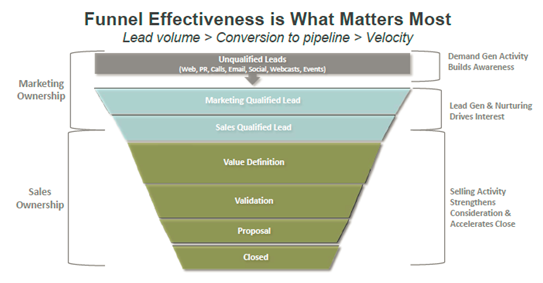Ask any technology entrepreneur, "If you had $150k to spend, would you add another salesperson or put those dollars into Marketing?" Most would do the former. Whether a startup and growth stage business, it is common for CEOs to place a higher importance on beefing up Sales, vs. Marketing. Why? It's pretty straightforward. Because Sales is accountable. Quotas and revenue goals set expectations, and based on Sales performance, you always know where your business stands.
For many first-time CEOs and CFOs, a Marketing stigma still exists, suggesting marketers are creatives, writers, event planners, publicists -- right-brained folks with little to no contribution to real business outcomes. These days are gone. Today's CEOs and CFOs must require Marketing leaders to use both sides of their brains to ensure every hour, every dollar spent is accountable and contributing to the goals of the business.
Investing in whole-brained marketing talent and holding them accountable is an acceleration lever, enabling more repeatability and predictability in the business, maximizing sales productivity, and reducing cost of sales. To achieve this, following are the marketing metrics that matter.
Five Marketing Metrics that Matter
1. Customer Acquisition Cost (& Marketing % of CAC)
2. Customer Lifetime Value to CAC Ratio (CLTV: CAC)
3. Time to Payback CAC
4. Marketing Contributed Revenue
5. Marketing Influenced Revenue
Definitions, calculations and benchmarks for these metrics are well covered in other Marketing blogs. Two of my favorites are:
- Hubspot's Marketing Blog --> http://blog.hubspot.com/marketing. The five metrics cited above are well defined in this article.
- Sales Benchmark Index --> http://www.salesbenchmarkindex.com/blog .
The Next-Level Metrics that Also Matter
Having a handle on the above topline metrics will clearly convey Marketing's contribution to the business, as well as lend credibility with the executive team and board members. The next-level metrics are also important, and there are many, but my view is the priorities can be classified into two categories: Funnel Effectiveness and Product Adoption. These are the day-to-day, month-to-month, quarter-by-quarter metrics to be continually tracked and optimized.
1. Funnel Effectiveness. This is all about measuring how things get into the funnel and move through it, and ensuring focus on continual improvement in the interest of acceleration and predictability. The key metrics are conversion and pace for each stage in the marketing funnel (as pictured below).

- Unqualified Leads (or Inquiries) at the top of the funnel represent someone "raising a hand" -- a distinct expressions of interest by a contact with contact details, whether an email click-through, website form submission, field marketing contact capture, inbound phone call/email, etc.
- Marketing Qualified Leads result from Inquiries or prospecting activity and match your target customer profile. For example, a director level or above in the Marketing function of a company that is a named account and/or within a target vertical.
- Sales Qualified Leads result from MQLs that have exhibited sufficient interest and has been qualified based on a certain level of criteria, e.g., budget, authority, need and timeline (BANT). An SQL is an initial meeting set with Sales, the equivalent of Stage 1 in opportunity pipeline in Salesforce.com (or other CRM).
These are the metrics the build toward Marketing Contributed and Marketing Influenced Revenue, as noted above. Conversion rates and velocity will vary based on your go-to-market model and marketing mix. For example, if you have a well-defined TAM with sales territories defined by named accounts, your demand generation activities should be very targeted, and if done right, could result in up to 50+% Inquiry to MQL conversion rate. Readiness is typically the factor when converting MQLs to SQLs (30-50% are decent benchmarks). I would expect true SQLs to convert to forecasted pipeline at 75-80%.
2. Product Adoption. Every technology product or solution has (or should have) key performance indicators for how customers derive value from it. Many refer to this as uptake. Companies with end-user products concern themselves with user activity, i.e., user log-in frequency and which features are being utilized. For many SaaS solutions, adoption may also be monitored based on other activity volume, e.g., While I was at LivePerson, it was chat volume, and at SundaySky, it was video view volume. These metrics tend to have direct correlation to churn rates, profit margin and upsell rates, and hence, are important to inspect and optimize regularly.
Just as the CMO and CRO have shared revenue goals, both the CMO and executive in charge of Customer Success should have shared adoption and retention goals with KPIs supported by a measurement system. (Sidebar: For earlier stage companies laser-focused on adding new logos, instituting this discipline can be easily back-burnered. Don't wait. You will not regret thinking this through and putting the necessary measures in place before you really need them.)
In today's digital age where everything is measurable, your Marketing organization needs to be fluent in what it takes to contribute to the bottom line. Arm your business with data and process-driven marketing talent and disciplines, and give Marketing a seat at the accountability table - right there alongside Sales.
Be sure to Subscribe here and follow us on Twitter to keep up with our latest perspective on Sales & Marketing Acceleration.

.png)